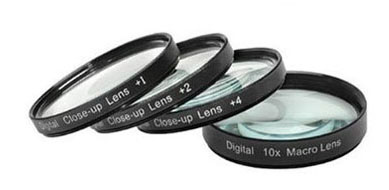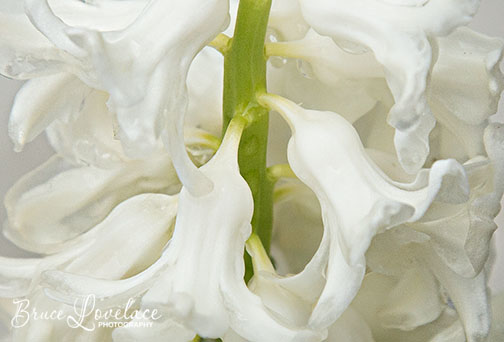HOW TO POSTS: LIGHTING AND COMPOSITION
filters for macro photography
Many serious macro photographers view filters for macro photography with a disdain. You shouldn't feel that way too. I know you've seen some spectacular images of flowers up really close, and perhaps some incredibly detailed photos of insects.
Imagine what it would be like to take your own eye-catching close-ups without having to buy an expensive macro lens. Perhaps you can. Here are three different filters that can be used for macro photography.
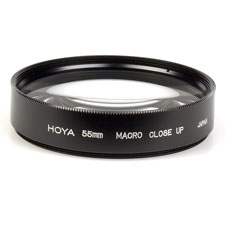 Screw on Macro Filter Screw on Macro Filter |
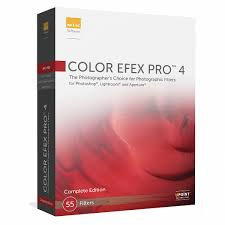 Software Filters Software Filters |
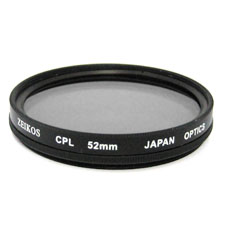 Polarizing Filter Polarizing Filter |
Some purist photographers refuse to use software filters to enhance their images. Others like me, use them occasionally. Then you have the heavy duty users of software macro filters that essentially fabricate an image that dramatically differs from the original close-up photo of the subject.
I understand both opinions on using software filters and I reside in the middle. Should we limit our use of post-capture software to only the small tweaks that attempt to match the resulting photo to the original scene? Let's cover that in a separate post. Let's dive into looking at the magnifying filters that are made to screw onto the camera lens for taking close-up pictures.
close-up filters for macro photography
Macro filters are one of the easiest and most affordable ways to dabble in close-up photography.
The very first filters I ever used, as a beginning photographer when I was about 10 years old, were close up filters. I had a set of 3 of them with different magnifications.
Similar to the reading glasses that many over-50 year olds must wear, these single optical element devices magnify the subject. They simple screw onto the front of your lens. They do not give you the best quality images, particularly at the edges of your photos where they go soft. But soft is not such a bad thing with some subjects, particularly flowers.
advantages of using macro filters
Money. Money. Money. Simple put, there the cheapest way to enter the world of macro photography. Macro lenses will be up to 10x more expensive to buy.
Simple to carry. You can carry a set of 4 macro filters in half the space and they weigh about 1/20th of the weight of carrying a dedicated macro lens.
Easy peasy. Lemon squeezy. Macro filters will work with any focal length, any brand of lens, and any camera. Just match the size of the lens barrel to the size of the filter.
Don't affect exposure. Unlike extension tubes, which may diminish the light by as much as a full f/stop (1/2 the light), magnifying lens filters do not affect your exposure. that might be the difference between using a specialized macro flash or not.
disadvantages of using macro filters
Not that magnified. Screw on filters do a great job of getting you closer with your existing lens, but you won't get true macro (1:1) magnification like is possible with a true macro lens or several extension tubes stacked together.
Optics. If you need super high quality optical performance, you should look elsewhere. Screw-on filters for macro photography aren't made with the same precision, nor with the same multi-coated lens elements, as macro lenses are. You just want to have some fun getting in close and enjoy the amazing world of close up photography, then you'll be quite happy with their performance.
how do macro photography filters work?
They work just like a pair of reading glasses. They are a single lens that screws onto the end of your existing camera lens and literally bends the light to allow you to focus much closer to your subject.

Macro photography filters come in a wide variety of different diameters. You can either match the filter size to your lens or you can get that step up or step down to match the filters you already have to the lens you are using.
These filters come with different magnifications ratings called diopter ratings such as +1, +2, +4, and +10, with +1 having the weakest magnifying and +10. Just like extension tubes, you can stack them to increase the magnification of your subject. Changing the order of how you screw multiple macro filters will also affect the magnification.
software filters for macro
This might be a little off topic, but I wanted to touch on another kind of filter for macro photography. Software "filters." Literally, it's a editing that filters the original pixels and enhances or alters your original photo. My attitude has changed with respect to post-capture editing with some of my macro photos, particularly when it comes to improving the detail.
Whether it was the original days of black and white film, then the first color film, followed by color transparencies (35mm slides) and now digital photography, capture had always involved an interpretation of the world though lenses, cameras, different media and with different processing mechanisms. The advent of digital photography has simply exploded the possibilities on how we'd can present the subject matter.
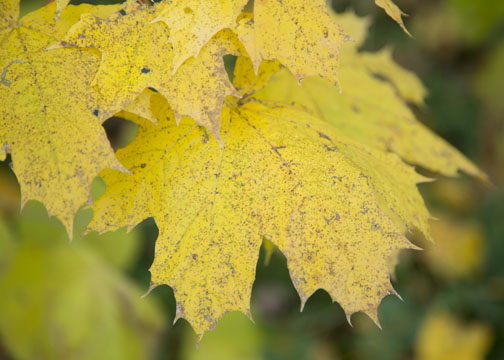 No filter Used
No filter Used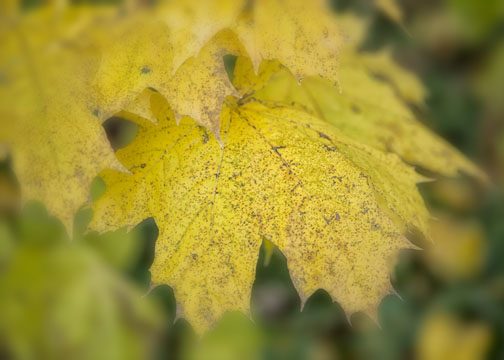 Edge blurring software filter used
Edge blurring software filter usedThe first photo above is straight out of the camera. The 2nd photo is the same subject, but this time with 2 software filters applied, Detail Extractor and Vignette Blur, both from from Nik Software. You can see how more detailed is revealed in the very center of the leaf and blur was applied to the surrounding areas.
What do you think? Do you liked the "filtered" image more? I really like what the detail extractor does with macro and nature photography. In this particular comparison, I'm personally not thrilled with the amount of blur in the second photo.
other filters for macro photography
1. UV or clear glass filter. Both of these filters protect the lens from damage and dirt. When you're shooting close-ups, the distance from your subject to the front of your lens may be quite small. The danger may not be great, depending on your subject, but protecting the lens is vital.
2. Polarizing Filter. Photographing macro objects outdoors often involves controlling the reflections from the sky on your subject. This is particularly true when photographing in wet conditions or taking photographs that have water in them.
Wet conditions often have a great effect on color saturation, but the reflections that are present from those smooth surfaces can block the details of your subject.
Using filters before and after image capture can dramatically affect your macro photographs. For the majority of photographers, both software and optical filters are great tools to expand your ability to create your own artistic impression of any subject. Have a blast!
lens filter accessories for macro photography
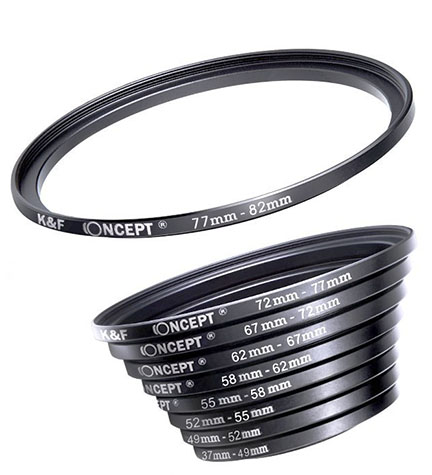 Adapter Rings
Adapter RingsLens filter adapter rings. If you have more than one lens, it's likely they they take a different size filter. With a set of ring adapters like this, you can use your filters on any lens you have.
If you are stepping down to a smaller filter on a bigger lens you will get some vignetting. Tip: compose your photo a little looser so that you can crop any unwanted vignetting when you are doing your photo editing.
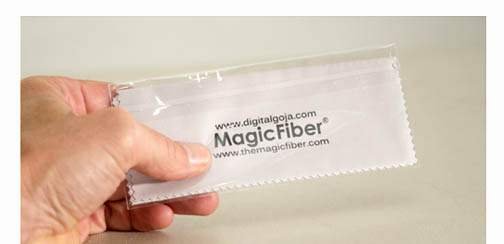 My Lens Filter Cleaner
My Lens Filter CleanerLens filter cleaning cloth. Best invention since sliced bread. Well, maybe not, but these cloths work so well. They're much pricier than lens cleaning tissue, but they suck up grease smudges like nothing else.
I have used the pre-moistened lens cleaning tissues with good success too. Sometimes it takes a while for the liquid cleaner to dry.
Advice: Keep your lens cloth in a sealable bag so that you can avoice any grit or dirt getting embedded in it.
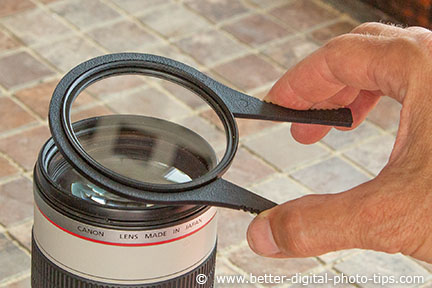 My Filter Wrench
My Filter WrenchLens filter wrench. You don't need these to screw your macro filters on, but if they ever get stuck, you'll be glad you have a wrench. This is one of my must have accessories I don't leave home without.
Filters can get stuck and applying to much uneven pressure on a lens barrel can destroy the lenses optics or focusing mechanism. I know-I ruined a lens once by trying to remove an accessory with too much brute strength. Filter wrenches provide equal force around the perimeter, making filter removal easy and safe.
Whatever filters for macro photography you decide to use, remember to enjoy the whole process. If it feels like a chore, you should change what you're doing. Have fun!


ABOUT BRUCE LOVELACE
Bruce is the publisher of this website. He is the author of the book "Improve Your Photography Instantly." Read more on Bruce on his Bio Page. He's been known as The Traveling Photographer ever since 1994. Read more about this website.
View some of Bruce's photos on Instagram. Visit the Facebook Page. Watch him on YouTube. Bruce runs photo workshops for kids and adults, and provides one-on-one photography coaching.
Digital Photography Education Location on Google My Business
Unique Filter That Lets You Change Shutter Speeds and F-Stops
Go to Digital Photography Tips Home Page
